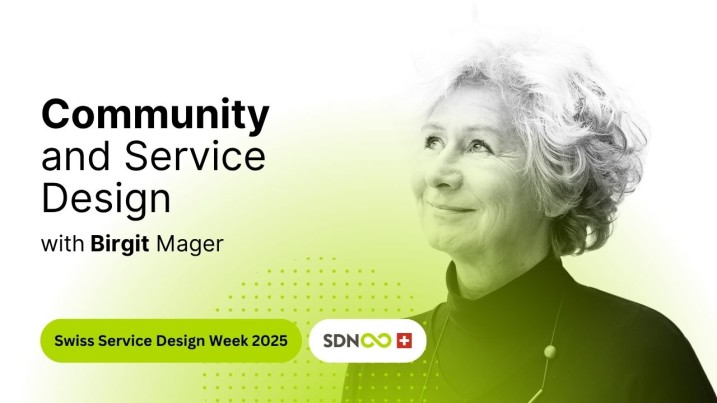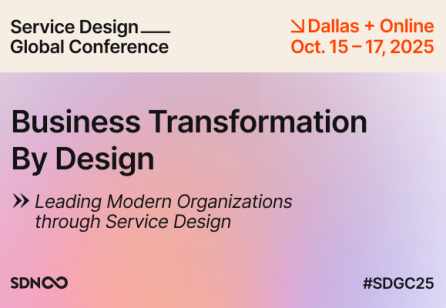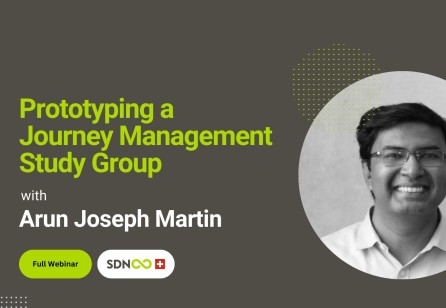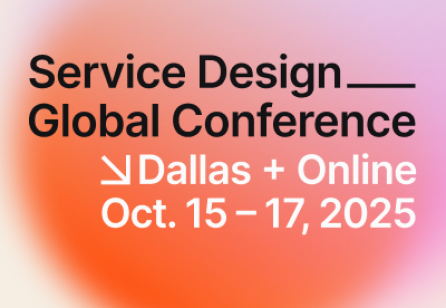Automated transcript
## Birgit's Background and Achievements
Tonight, we will be with Birgit. And Birgit is a president and co-founder of the International Service Design Network. After some years as an in-house organizational developer and systemic consultant with companies like Helvett Packard. Birgit Mager's interest shifted to the power paradigm change from products and technology towards services and how to help companies go through that transition.
In 1995, Birgit started teaching as a professor for Service Design at the University of a Applied Science Cologne in Germany. As she was the first professor ever in this field, she always felt that it is part of the responsibility as a professor to create awareness and interest in the graduates and make sure they will find jobs.
And that's also why, in 2004, she co-founded the Service Design Network, SDN, which is the leading nonprofit institution for expertise in Service Design and a driver of global growth, development and innovation within the practice. It's my pleasure to welcome on the stage Birgit! Welcome Birgit!
Wow. Thank you Daniele, for this amazing introduction, and thank you for inviting me to the big small Switzerland. That Switzerland was leading Service Design. It was the first country to have a Service Design award in 1998. It was the first country to ever have a Service Design exhibition in Zurich, in the Kunst Halle in 2001.
So small Switzerland is really big on service. Design, and I'm really happy to see how you are driving the energy of this community and also so lovely how you attract people from all over the world. So good morning, good afternoon, good evening to everybody.
## Service Design: Importance and Impact
I'm going to talk about Service, Design and community.
As Daniele has said, I'm teaching Service Design since 1995, and ever since I have observed how different organizations and communities have been measuring the value of.
Design and Service Design. So for example, the design council UK in 2005 came up with the number that design oriented companies are 200% more successful at the stock market. A little bit later in 2018, McKinsey came up with the MDI, the McKinsey Design Index, and they. Companies that are using design in a strategic way are well 10% higher in the performance than non-design companies.
I could go on and on with this. There are many measures and if you are into Service Design, you should be aware of those because they are good arguments when you talk to clients or potential clients to sell Service Design.
## Challenges and Ethical Considerations in Design
On the other hand, we should be aware that all these measures are. A tendency to use or misuse design as an agent of marketing.
So even though design has positioned itself on a strategic level, even though design is claiming that we are human centered, even though we are claiming that we carry DEI in our DNA still in order to liaise. Successfully with clients, we often support the selling part, the selling of services, and potentially products where it is questionable if people really need them, if they can really afford them, and if they are really relevant in the times that we are facing today because.
We are facing huge challenges and we are all aware that the social injustice, the exploitation of our planet and the threats that we are facing through politics that are not always inclusive or diverse we are facing these huge challenges and there is no space for. Design that puts lipstick on the pig's lips as Dan Hill has phrased it eights ago.
We need to reconsider if the neoliberal economics are the only framework within which we as designers and Service Design can work. And we need to be open to not only relate to our. Clients on a business level, but also to challenge them with their thinking and bring new models of business into the conversation.
I assume that most of you are aware of the donut economy and I think that is something that we need to know this and other models because the challenges we are facing. Do not allow to relieve that. The future is just a prolongation of the past. The author of the Theory, you said that we all tend to maintain the status quo and that we all tend to be fascinated with new technologies, and that we hope that they will solve the problems we are facing.
And this can be described as a resistance combined with the longing for the social and moral orders of the past, and the anger of him having lost control over the future. The way we deal with the future is based on the past, but the future is something that is different from the past and different of the models that we are familiar with.
Ger, who was responsible for planning and strategy at Royal Dutch in the Netherlands one said the signals of the new reality do not penetrate the immune system of organizations. And that is something that we as designers and service designers should challenge. We should try to bring the signals of the new reality, A reality that asks for sustainable action, for social fairness, for new way of sharing wealth.
We should make these new values. Part of the organizations and I would like to share a bit of the design evolution because as I said, design used to be partner of marketing and it was the main focus of design to grow. Product sales to grow market shares. But throughout the years we have seen that design has moved into the C level and that it is more part of strategic development that has moved from the design of products to product service systems, that it is moving from a human centered to a more planet centered design, and that is moving to assist in design for the common good.
That's now where we come back to the community component. We as designers should bring a new thinking into organizations and not just prettify and beautify the existing system. So we are agents of the future and thus we need to be aware of new opportunities for business.
## Innovative Business Models and Examples
Economic models and I want to share a couple of examples with you.
Based on the on the donut economy and based on new ways of understanding value creation in the economy. And this is based on the concept of the comments. I assume most of you have already heard of that. The comments is a movement and is at the same time just a. Shared resources that are accessible to all members of a society, of or community.
The comments referred to resources that can be tangible such as land, water, forests, or they can be intangible, such as knowledge, culture, or digital information. And the communities have developed norms, rules, and systems for managing these common resources to ensure sustainability and equity. So this sounds rather heavy.
And I would like to fill it up with some lightness by an example that students of mine did at the current International School of Design. In a couple of years ago, it was two BA students and they approached me asking if they would supervise their BA thesis, and that was about creating a bar.
I said a bar. Okay. That sounds like an interesting BA project. You mean a place for drinking? Yes. But we wanna create that bar as a cooperative. So shared ownership, shared responsibility and shared drinking. So the think is a concept where the old concept of cooperatives, which by the way in Switzerland has has deep roots.
Negras, for example, is a cooperative, but the concept of cooperatives has lost relevance in everyday life. People do not really know what comments are anymore. The barriers to entry are high. Because it is a lot of administrative work to build a co, a cooperative. And the participation principles are binary, not really relate to democracy.
So that project wanted to translate the old concept of shared ownership in a cooperative. Into something that is a high everyday relevance that addresses common interest, creates low barriers to entry, lowest diverse participation, and creates a democratic experience giving trust to the into democracy.
So throughout the BA thesis, the students worked on shared values, growing a team of people who were interested in building that cooperative. Creating values about self-help, self-governance, democracy, equality, and solidarity, all related to building a bar. And throughout the thesis, they managed to bring together 60 people that wanted to co-create that cooperative.
And in the year 2022, they opened it. It's a bar, it's a place to drink, but it's at the same time a cooperative. It's co-owned. It's co-created. It creates value that is shared, and the value that it brings is co-created by the owners who are all in the same position. There is no hierarchy. There is no power place.
And it's an amazing place where they just co-create not only the drinks that they serve, but also the events that they share and the conversations and and activities that they have. So today that cooperative has 250 members. They are employing two people. On a full-time level, they are profitable business.
They do concerts, talks, markets, consulting and others. So this kind of using Service Design as a way to create something that is beyond the hierarchical, exploitative business as we know it using Service Design to create, co-create something that is about shared ownership. Still profitability, but a profitability that is shared between all those who own it.
I think that is amazing. And we as service designers should actively reflect on the opportunities that those commons, those business models that go beyond neoliberal economy create. Just another short glimpse at another thing that we did. I assume that you all know repair cafes. Repair cafes are usually volunteer driven, community owned by passionate people like the Service Design community, passionate about repairing as we are passionate about Service Design.
We used the Service Design approach in order to. How communities perceive repair Cafe, and we found many let's say opportunities and how to better communicate the existence of cafe. And to give better access to these repair coffees. So one thing that we did, we created a mobile repair coffee that can go to markets, to events, to schools, to kindergartens in order to share the idea of sustainability.
Through repairing and we work together with those volunteers from the community of Repair Cafe and use the Service Design approach to improve their communication and their visibility and accessibility.
## Encouragement and Community Engagement
I would like to encourage you. Oh, that's me repairing it's co repairing. I would like to encourage you in your work to take the common lens to reflect how you can bring more shared ownership shared.
Economic responsibility into the Service Design projects you are doing. And if you want to learn more about that, I would like to also encourage you to take advantage of touchpoint. It's for free for the members of our community, of the Service Design community. And lately we had an issue about redefining value creation.
There, you can really dive deep into the comments and what it means to put a new lens on our economy. And I would like to encourage you to join the community if you are not yet a member. Become a member, full member or a community member. And take advantage of all the different things that we offer.
Do a self-assessment to see on what level of Service Design you are as a service designer. Take advantage of the Service Design Network member month with a discount. And have a look at the huge conference that we are organizing as a hybrid event in Dallas and online in October, 2025 to share your experience and to learn from others to, make Service Design really impactful, also impactful beyond traditional ways of value creation.
So be part of the Service Design community and make sure to contribute as the Service Design chapter of Switzerland does. It's all volunteers and we are all super enthusiastic to grow and to create this community.
## Q&A Session
I'm now open for questions. So please feel free.
Thank you so much for these inspirations. If I had to summarize it I see a lot of insights in it, but if I had to pick three, I will say take the common lens. That's really one that was very strong and that I really felt the make people co-own it, not just. Be part of it, but really co-own it.
And then another one that I, that really stuck with me is one of those tiny detail details of Bring the Community where it already is. We had that with this Beautiful bike thing. We have a lot of questions for you, so I'm gonna drive in directly in the questions. We have a question from the south of Switzerland from Emmanuel who asks Great Talk Birgit.
And thanks for all what you have created in Service Design. Do you see some links between the field of Service Design and change management?
Thank you for that question, Emmanuel. Yes, I definitely do. As as Daniele mentioned earlier I started as an organizational developer in the late eighties, early nineties of the last century.
And that's basically where I developed my. Ideas about Service Design because Service Design is dealing with systems, with organizations, with teams, with people. And in order to create innovation, to create change within these systems, you need to have a substantial understanding of what organizations are and how change.
Within these organizations can be triggered. And I strongly believe that the key principles of change management, like create a sense of urgency create a hunger for change. Take the low hanging fruit, create success stories. So all these basic principles of change management are definitely extremely relevant for Service Design.
And the service designer that wants to go beyond classical user research and beyond polishing user journeys should definitely familiarize him or herself with the principles of change management and organizational develop development.
Thank you so much. We have a question coming directly from Iran from Lely who has been following this Service Design week from day one, and I'm sure she will be there also on, on the last day though.
First of all, thank you Lely for being such a engaged community member, and she's saying thank you for your time and valuable insights. I'm curious if you could redesign one aspect of the Service Design community worldwide, what would it be?
Wow. That's a cool question. Thank you, lady. Yeah, to be honest, when I founded the Service Design Network it was a project at the university. But then step by step it became bigger and it was clear that we needed some kind of an organizational framework in order to run huge conferences worldwide. So in the year 2011 it was a conference in San Francisco that made me create a nonprofit Gigha.
It's a, it's. Nonprofit organization. And the I am the CEO. I cannot earn any money with it, and I don't want to earn any money with it, but I have the full responsibility. So if I would do anything differently. I still can do it differently is I would create the Service Design Network as a commons as a commons that is co-owned by all the members that is co-created, which it is basically by all the members and where the value will be.
Yes, really in the community. Nonprofit organization does a lot of that. But still the ownership and the responsibility right now are with one person, and that is just not appropriate, neither for a sustainable future, nor for the the wi vibes of this community who should really own the network.
So that is something that I would do differently and that I'm indeed planning to do differently within the next few years.
Thank you so much. We have a question from Juliana, which is very well targeted for the Swiss culture, which is, I have a question around the area of Service Design and tourism. How can values like democracy and equality reshape the power dynamics between tourists, locals, and institutions in tourism planning?
Oh my God. Complex questions. A. That's a big one. And I would if I could talk to you, I would ask you for your own answer because it sounds as if you are strongly and deeply involved in the tourism domain. I think Service Design does already help to create shared values. Between the different stakeholders in tourism.
I can observe in Austria and Switzerland, for example, but also in Latin American countries. How the need for shared values between the different stakeholders is triggered through Service Design projects. That the exploitation of resources being it human resources are natural resources.
Is is being stopped. But I have to say, that's about all I can say. Service Design should be part of the co-creation between the different stakeholders in the tourism industries to put values at the forefront of the design of touristic experiences that are sustainable in the social, economic and ecological domain.
Thank you so much and I'm sure Juliana will connect with you personally. Maybe to go deeper on that one. I'm on LinkedIn, so
feel free to connect.
Wonderful. We have one which is a little bit shorter and and in a framing that I really love, love NAV is asking my question for you is, if Service Design is a skill, how can we train this skill?
I like we do with the muscle.
Hi Nav. Hello to Frankfurt or Singapore or wherever you are. First of all, I would say Service Design is not just a skill. I always say that Service Design is a mindset, it's a process and it's a methodology. And whereas in the. Early times of Service Design. We focused a lot on the skills and methods.
We were super proud on our, stakeholder maps and our journey maps on our personas that would be like one-to-one human representing the different personas in the boardrooms and three meter long journey maps that were beautifully crafted. So we would, we focused a lot about the skills and the methodologies. And nowadays it seems that we we focus really more on the mindset and we, I think as soon as the. Partners in organizations strongly believe that you cannot do a project without really understanding the problem.
And as soon that they understand that you should not jump on the first solution, and as soon as they understand that you should not implement a solution before having Prototype tested and iterated it. Just taking these three key moments, do deep research, do. Intense creation. Don't jump on the first solution.
Do prototyping and testing. So these three things just to name, these are part of a mindset that, from my point of view, is much more important than having the skill to craft a beautiful journey map, which is also important, but it comes second.
Thank you so much for sharing all of that.
## Conclusion and Final Thoughts
We already come to the conclusion of this event, but before I let you go, we have a lot of lovely messages for you.
We have Gerardo, who is saying, thank you so much for sharing your knowledge and insights. We have Emmanuel who's saying thank you so much for seeing these insight ette and we have even more people. Obviously we could do ours, just of thank you messages, but really people appreciate the fact that you take, that you took time today to be here with us and to share three insights, answer three questions, and even answer one bonus.
Question. Thank you so much. You, thank you Daniele,
for the lovely facilitation and thanks everybody for joining. Happy to be part of this community.
Thank you so much. Cheers to everyone and have a lovely end of the day. Bye-bye.
Bye-bye.
This transcript was generated automatically using Descript. It wasn't reviewed and therefore contains some creative sentences and mistakes.








Share your thoughts
0 RepliesPlease login to comment